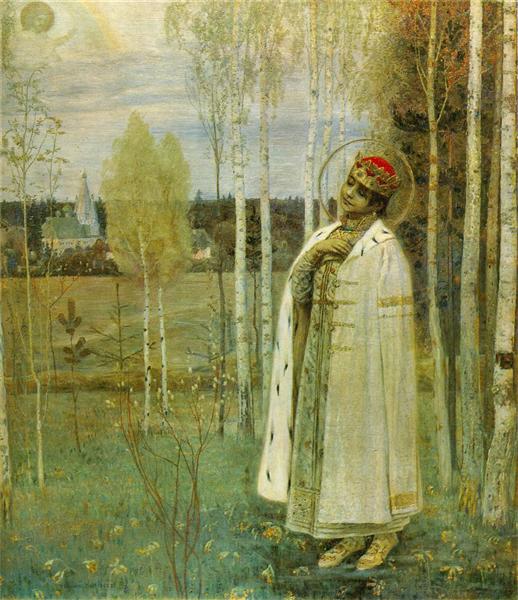
Back in 1895, Nesterov visited Uglich to paint sketches for “The Murdered Dmitry Tsarevich.” Here he goes to the museum, converted from the palace of the tsarevich, where he sees many icons with his image. In church, he examines the veil sewn by the mother of the murdered in memory of him in silks and gold. Nesterov’s travel companion, writer V.M. Mikheev, manages to find an old legend about the “Youth – a Martyr”. In Uglich, Nesterov makes a landscape sketch from those places that could have been the background of the death of the tsarevich.
The morning spring landscape was especially successful for the artist. This is a jubilant, light world. Nesterov lovingly caresses every detail with his brush – yellow flowers in the foreground, fluffy willow, thin white birch trees covered with spring fluff. A cozy church can be seen in the distance. Without touching the meadow with his feet, a regal child in a golden crown hovers above the ground, with a tender smile on his face. “The soul of the tsarevich was already hovering among the spring birches of old Uglich” – this effect was achieved by Nesterov in the picture. In fact, it affirmed the spring jubilation of eternal life, faith in which was so necessary at that moment for Nesterov, the father of a child on the verge of death.
The painting uses elements of the icon – a halo over the head of the prince, Savior in the sky, blessing him. Nesterov managed to achieve their organic fusion with the landscape.
The light bluish-green range of colors is accentuated by a single bright spot – the scarlet cap of the prince. It is perceived as a scream interrupting a gentle lyrical melody.
A. Benois spoke critically about the church murals of Vasnetsov and Nesterov, but added: “… if Nesterov wrote only his church murals, which are no different in sweetness and artificiality from Vasnetsov’s fake creations, then he would be of very little interest, since copies of cannot be compared with the originals. However, Nesterov deserves a completely different attitude, since he created not only his icons, but also several (unfortunately not many) paintings, in which he managed to put a lot of personal in essence and significance that surpasses even Vasnetsov’s work. But in these works of the last kind, Nesterov is already an artist of a new period, a period of free, personal and “inspired” beginnings in art. ” Nesterov agreed with this judgment.
Year of painting: 1899.
Painting dimensions: 197 x 175 cm.
Material: canvas.
Writing technique: oil.
Genre: religious painting.
Style: symbolism.
Gallery: State Russian Museum, St. Petersburg, Russia.